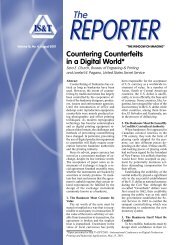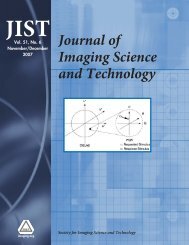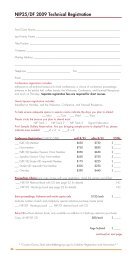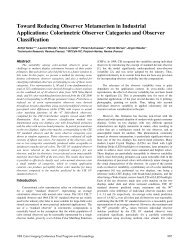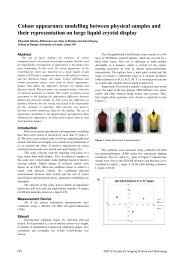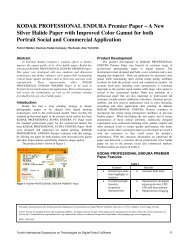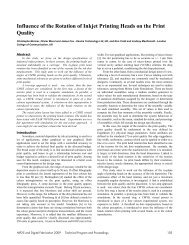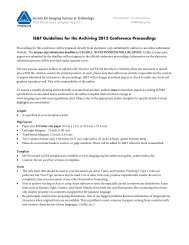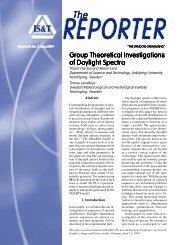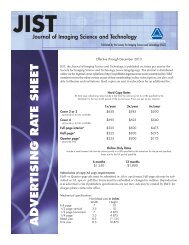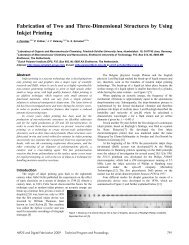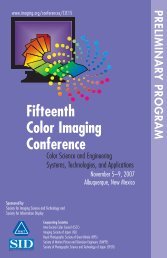JIST - Society for Imaging Science and Technology
JIST - Society for Imaging Science and Technology
JIST - Society for Imaging Science and Technology
Create successful ePaper yourself
Turn your PDF publications into a flip-book with our unique Google optimized e-Paper software.
Lee et al.: Digital color image halftone: Hybrid error diffusion using the mask perturbation <strong>and</strong> quality verification<br />
Figure 11. Inputs of the structural similarity measure <strong>and</strong> the color image similarity measure.<br />
SSIM algorithm is exp<strong>and</strong>ed to RGB color. The structural<br />
similarity method was proposed by Wang et al. 16,17 The<br />
SSIM compares local patterns <strong>for</strong> pixel intensities that have<br />
been normalized <strong>for</strong> luminance <strong>and</strong> contrast between a reference<br />
image <strong>and</strong> a distorted image. The MSSIM is the mean<br />
structural similarity measure <strong>for</strong> entire image. The details of<br />
the SSIM <strong>and</strong> MSSIM are in Appendix II (available as<br />
Supplemental Material on IS&T website, www.imaging.org).<br />
In this paper, we exp<strong>and</strong> the concept of MSSIM to color<br />
images. The input of the structural similarity measure part is<br />
x R,G,B<br />
m,n <strong>and</strong> y R,G,B<br />
m,n, which was already processed<br />
with consideration of the HVS. The final output of CISM is<br />
the weighted sum of the MSSIM value <strong>for</strong> each channel in<br />
RGB color as shown in<br />
CISMx,y = w i MSSIMx,y,<br />
i<br />
20<br />
where w i is the weight <strong>for</strong> each channel in RGB color. In this<br />
paper, we used the value of w i =1/3.<br />
Figure 12. Comparison of the structural similarity measure <strong>and</strong> the color<br />
image similarity measure: Floyd–Steinberg error diffusion raster scan.<br />
Evaluation <strong>and</strong> Experimental Results<br />
In order to verify the proposed algorithm, we compared the<br />
conventional error diffusion algorithm, Floyd–Steinberg error<br />
diffusion algorithm, 1 vector color error diffusion, 7 <strong>and</strong><br />
Shiau–Fan error diffusion 10 with the proposed algorithm.<br />
Results of Halftone Statistics<br />
The results of pair correlation <strong>and</strong> RAPSD are shown in<br />
Figures 9 <strong>and</strong> 10. The input image resolution is a 128<br />
128 pixel image with a gray level of 28 as shown in Fig. 4.<br />
Figure 9 is the result of the Floyd–Steinberg algorithm, <strong>and</strong><br />
Fig. 10 is the result of hybrid error diffusion. For the result<br />
of pair correlation, Rr=0 <strong>for</strong> r3.5 is a consequence of<br />
the inhibition of points within a distance of 3.5 of each<br />
other. The more frequent occurrence of halftone result is in<br />
the distance of 4.5r7.5 with the condition of Rr1.<br />
There is no area <strong>for</strong> the case of Rr=0 in Fig. 10. This<br />
means that the hybrid error diffusion can offer the chance of<br />
occurrence in the RGB mixed model.<br />
For the result of RAPSD, it has a power spectrum that is<br />
composed entirely of high frequencies, in the case of the<br />
Floyd–Steinberg algorithm in Fig. 9. However, the power<br />
spectrum of hybrid error diffusion is extended to the lower<br />
Figure 13. Objective evaluation results: Color image similarity measure.<br />
frequency area <strong>and</strong> the high frequency components are suppressed.<br />
This means that the density of a dot is increased<br />
<strong>and</strong> spread with a good pattern profile.<br />
Results <strong>for</strong> the Gradation Characteristic<br />
First, we try to show the capability of MSSIM <strong>and</strong> CISM to<br />
assess the halftone image quality. We used the Floyd–<br />
Steinberg error diffusion (raster scan) as a test halftone<br />
396 J. <strong>Imaging</strong> Sci. Technol. 515/Sep.-Oct. 2007




